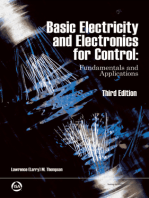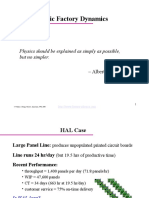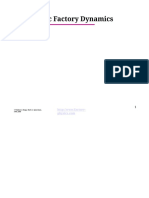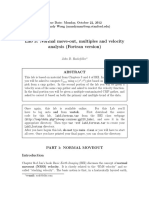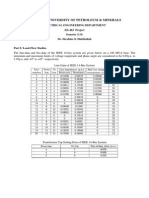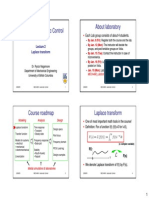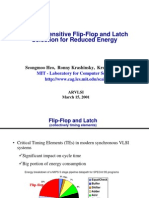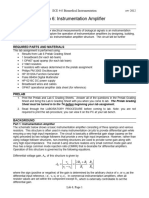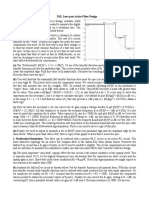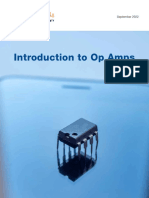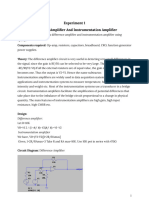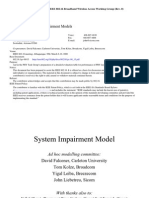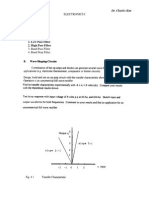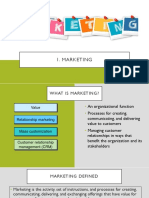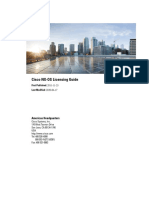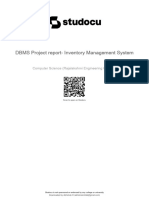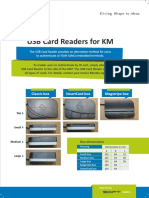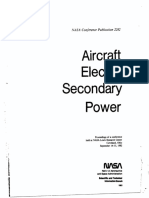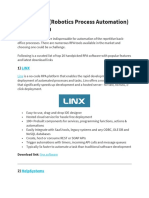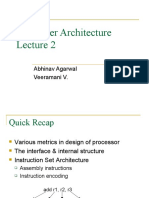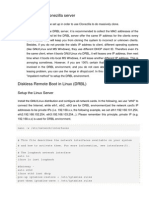Chapter 07
Chapter 07
Uploaded by
albgatmtyCopyright:
Available Formats
Chapter 07
Chapter 07
Uploaded by
albgatmtyCopyright
Available Formats
Share this document
Did you find this document useful?
Is this content inappropriate?
Copyright:
Available Formats
Chapter 07
Chapter 07
Uploaded by
albgatmtyCopyright:
Available Formats
Wallace J. Hopp, Mark L. Spearman, 1996, 2000 http://www.factory-physics.
com
1
Basic Factory Dynamics
Physics should be explained as simply as possible,
but no simpler.
Albert Einstein
Wallace J. Hopp, Mark L. Spearman, 1996, 2000 http://www.factory-physics.com
2
HAL Case
Large Panel Line: produces unpopulated printed circuit boards
Line runs 24 hr/day (but 19.5 hrs of productive time)
Recent Performance:
throughput = 1,400 panels per day (71.8 panels/hr)
WIP = 47,600 panels
CT = 34 days (663 hr at 19.5 hr/day)
customer service = 75% on-time delivery
What data do we need to decide?
I s HAL lean?
I f not, what are levers for improvement?
Wallace J. Hopp, Mark L. Spearman, 1996, 2000 http://www.factory-physics.com
3
HAL - Large Panel Line Processes
Lamination (Cores): press copper and prepreg into core blanks
Machining: trim cores to size
Internal Circuitize: etch circuitry into copper of cores
Optical Test and Repair (Internal): scan panels optically for defects
Lamination (Composites): press cores into multiple layer boards
External Circuitize: etch circuitry into copper on outside of composites
Optical Test and Repair (External): scan composites optically for defects
Drilling: holes to provide connections between layers
Copper Plate: deposits copper in holes to establish connections
Procoat: apply plastic coating to protect boards
Sizing: cut panels into boards
End of Line Test: final electrical test
Wallace J. Hopp, Mark L. Spearman, 1996, 2000 http://www.factory-physics.com
4
HAL Case - Science?
External Benchmarking
but other plants may not be comparable
Internal Benchmarking
capacity data: what is utilization?
but this ignores WIP effects
Need relationships between WI P, TH, CT, service!
Wallace J. Hopp, Mark L. Spearman, 1996, 2000 http://www.factory-physics.com
5
Basic Definitions
Workstation: a collection of one or more identical machines.
Part: a component, sub-assembly, or an assembly that moves through the
workstations.
End Item: part sold directly to customers; relationship to constituent
parts defined in bill of material.
Consumables: bits, chemicals, gasses, etc., used in process but do not
become part of the product that is sold.
Routing: sequence of workstations needed to make a part.
Order: request from customer.
Job: transfer quantity on the line.
Wallace J. Hopp, Mark L. Spearman, 1996, 2000 http://www.factory-physics.com
6
Basic Measures
Throughput (TH): for a line, throughput is the average quantity of
good (non-defective) parts produced per unit time.
Work in Process (WIP): inventory between the start and endpoints of
a product routing.
Raw Material Inventory (RMI): material stocked at beginning of
routing.
Crib and Finished Goods Inventory (FGI): crib inventory is
material held in a stockpoint at the end of a routing; FGI is material
held in inventory prior to shipping to the customer.
Cycle Time (CT): time between release of the job at the beginning of
the routing until it reaches an inventory point at the end of the
routing.
Wallace J. Hopp, Mark L. Spearman, 1996, 2000 http://www.factory-physics.com
7
Factory Physics
Definition: A production system is a goal-oriented network of
processes and stockpoints through which parts flow.
Structure: Network is made up of routings (lines), which in turn are
made up of processes.
Focus: Factory Physics is concerned with the network and flows at
the routing (line) level.
Wallace J. Hopp, Mark L. Spearman, 1996, 2000 http://www.factory-physics.com
8
Parameters
Descriptors of a Line:
1) Bottleneck Rate (r
b
): Rate (parts/unit time or jobs/unit time)
of the workstation with the highest long-term utilization.
2) Raw Process Time (T
0
): Sum of the long-term average
process times of each station in the line.
3) Congestion Coefficient (o): A unitless measure of
congestion.
Zero variability case, o = 0.
Practical worst case, o = 1.
Worst possible case, o = W
0
.
Note: we wont use o quantitatively,
but point it out to recognize that lines
with same r
b
and T
0
can behave very
differently.
Wallace J. Hopp, Mark L. Spearman, 1996, 2000 http://www.factory-physics.com
9
Definition of Bottleneck
Why do we use highest utilization instead of slowest to define
the bottleneck?
A B
r
1 min 2 min
y
1-y
5 . 0 if ) 2 ( ) 1 (
2
5 . 0
) 2 (
1
) 1 (
capacity
in rate
> s
=
=
= =
=
y u u
ry
y r
u
r
r
u
u
If yield loss is greater than 50% then station 1 becomes the bottleneck
because it processes more jobs than station 2. The same thing
happens with systems that have multiple routings.
Wallace J. Hopp, Mark L. Spearman, 1996, 2000 http://www.factory-physics.com
10
A Simple Relationship
Critical WIP (W
0
): WIP level in which a line having no
congestion would achieve maximum throughput (i.e., r
b
) with
minimum cycle time (i.e., T
0
).
W
0
= r
b
T
0
Wallace J. Hopp, Mark L. Spearman, 1996, 2000 http://www.factory-physics.com
11
The Penny Fab
Characteristics:
Four identical tools in series.
Each takes 2 hours per piece (penny).
No variability.
CONWIP job releases.
Parameters:
r
b
=
T
0
=
W
0
=
o =
Wallace J. Hopp, Mark L. Spearman, 1996, 2000 http://www.factory-physics.com
12
The Penny Fab
WIP TH CT TH x CT
1
2
3
4
5
6
7
8
9
Wallace J. Hopp, Mark L. Spearman, 1996, 2000 http://www.factory-physics.com
13
TH vs. WIP: Best Case
T
h
r
o
u
g
h
p
u
t
(
J
o
b
s
/
h
r
)
0 2 4 6 8 10 12 14
0
.2
.4
.3
.5
.1
WIP (Jobs)
Wallace J. Hopp, Mark L. Spearman, 1996, 2000 http://www.factory-physics.com
14
CT vs. WIP: Best Case
C
y
c
l
e
t
i
m
e
(
H
o
u
r
s
)
0 2 4 6 8 10 12 14
0
8
16
12
20
4
WIP (Jobs)
Wallace J. Hopp, Mark L. Spearman, 1996, 2000 http://www.factory-physics.com
15
Best Case Performance
Best Case Law: The minimum cycle time (CT
best
) for a given
WI P level, w, is given by
The maximum throughput (TH
best
) for a given WI P level, w is
given by,
s
=
otherwise.
if
, /
,
) ( CT
0 0
best
W w
r w
T
w
b
s
=
otherwise.
if
,
, /
) ( TH
0 0
best
W w
r
T w
w
b
Wallace J. Hopp, Mark L. Spearman, 1996, 2000 http://www.factory-physics.com
16
Best Case Performance (cont.)
Example: For Penny Fab, r
b
= 0.5 and T
0
= 8, so W
0
= 0.5 8 = 4,
which are exactly the curves we plotted.
s
=
otherwise.
4 if
, 2
, 8
) ( CT
best
w
w
w
s
=
otherwise.
4 if
, 5 . 0
, 8 /
) ( TH
best
w w
w
Wallace J. Hopp, Mark L. Spearman, 1996, 2000 http://www.factory-physics.com
17
A Manufacturing Law
Little's Law: The fundamental relation between WI P, CT, and
TH over the long-term is:
Insights:
Fundamental relationship
Simple units transformation
Definition of cycle time (CT = WIP/TH)
CT TH WIP =
hr
hr
parts
parts =
Wallace J. Hopp, Mark L. Spearman, 1996, 2000 http://www.factory-physics.com
18
Penny Fab Two
10 hr
2 hr
5 hr 3 hr
Wallace J. Hopp, Mark L. Spearman, 1996, 2000 http://www.factory-physics.com
19
Penny Fab Two
Station
Number
Number of
Machines
Process
Time
Station
Rate
1 1 2 hr j/hr
2 2 5 hr j/hr
3 6 10 hr j/hr
4 2 3 hr j/hr
r
b
= ____________ T
0
= ____________ W
0
= ____________
Wallace J. Hopp, Mark L. Spearman, 1996, 2000 http://www.factory-physics.com
20
Worst Case
Observation: The Best Case yields the minimum cycle time and
maximum throughput for each WIP level.
Question: What conditions would cause the maximumcycle time
and minimumthroughput?
Analysis:
throughput cannot be worse than one job in empty line
use Littles law to get worst possible cycle time
Results are exactly what you get if every job in the line is moved in
a single batch between stations.
Wallace J. Hopp, Mark L. Spearman, 1996, 2000 http://www.factory-physics.com
21
Worst Case Performance
Throughput: TH >
1/T
0
0
0.1
0.2
0.3
0.4
0.5
0.6
0 1 2 3 4 5 6 7 8 9 10 11 12
WIP
T
H
r
b
W
0
1/T
0
Best Case
Worst Case
0
4
8
12
16
20
24
28
32
0 1 2 3 4 5 6 7 8 9 10 11 12
WIP
C
T
T
0
W
0
Best Case
Worst Case
0
0
/ 1
wT
T
WIP
TH
WIP
CT = s =
Littles Law:
Wallace J. Hopp, Mark L. Spearman, 1996, 2000 http://www.factory-physics.com
22
Worst Case Performance
Worst Case Law: The worst case cycle time for a given WI P
level, w, is given by,
CT
worst
(w) = w T
0
The worst case throughput for a given WI P level, w, is given
by,
TH
worst
(w) = 1 / T
0
Randomness?
None - perfectly predictable, but bad!
Wallace J. Hopp, Mark L. Spearman, 1996, 2000 http://www.factory-physics.com
23
Practical Worst Case
Observation: There is a BIG GAP between the Best Case and
Worst Case performance.
Question: Can we find an intermediate case that:
divides good and bad lines, and
is computable?
Experiment: consider a line with a given r
b
and T
0
and:
1. single machine stations
2. balanced lines
3. variability such that all WIP configurations (states) are equally
likely
Wallace J. Hopp, Mark L. Spearman, 1996, 2000 http://www.factory-physics.com
24
PWC Example 3 jobs, 4 stations
State Vector State Vector
1 (3,0,0,0) 11 (1,0,2,0)
2 (0,3,0,0) 12 (0,1,2,0)
3 (0,0,3,0) 13 (0,0,2,1)
4 (0,0,0,3) 14 (1,0,0,2)
5 (2,1,0,0) 15 (0,1,0,2)
6 (2,0,1,0) 16 (0,0,1,2)
7 (2,0,0,1) 17 (1,1,1,0)
8 (1,2,0,0) 18 (1,1,0,1)
9 (0,2,1,0) 19 (1,0,1,1)
10 (0,2,0,1) 20 (0,1,1,1)
clumped
up states
spread
out states
Note: average WI P at any station is 15/20 =0.75,
so jobs are spread evenly between stations.
Wallace J. Hopp, Mark L. Spearman, 1996, 2000 http://www.factory-physics.com
25
Practical Worst Case
Let w = jobs in system, N = no. stations in line, and t =
process time at all stations:
CT(single) = (1 +(w-1)/N) t
CT(line) = N [1 +(w-1)/N] t
= Nt +(w-1)t
= T
0
+(w-1)/r
b
TH =WI P/CT
=[w/(w+W
0
-1)]r
b
From Littles Law
Wallace J. Hopp, Mark L. Spearman, 1996, 2000 http://www.factory-physics.com
26
Practical Worst Case Performance
Practical Worst Case Definition: The practical worst case
(PWC) cycle time for a given WI P level, w, is given by,
The PWC throughput for a given WI P level, w, is given by,
where W
0
is the critical WI P.
b
r
w
T w
1
) ( CT
0 PWC
+ =
,
1
) ( TH
0
PWC b
r
w W
w
w
+
=
Wallace J. Hopp, Mark L. Spearman, 1996, 2000 http://www.factory-physics.com
27
TH vs. WIP: Practical Worst Case
0
0.1
0.2
0.3
0.4
0.5
0.6
0 1 2 3 4 5 6 7 8 9 10 11 12
WIP
T
H
r
b
W
0
1/T
0
Best Case
Worst Case
PWC
Good (lean)
Bad (fat)
Wallace J. Hopp, Mark L. Spearman, 1996, 2000 http://www.factory-physics.com
28
CT vs. WIP: Practical Worst Case
0
4
8
12
16
20
24
28
32
0 1 2 3 4 5 6 7 8 9 10 11 12
WIP
C
T
T
0
W
0
Best Case
Worst Case
PWC
Bad (fat)
Good
(lean)
Wallace J. Hopp, Mark L. Spearman, 1996, 2000 http://www.factory-physics.com
29
0
0.1
0.2
0.3
0.4
0.5
0 2 4 6 8 10 12 14 16 18 20 22 24 26
WIP
TH
Penny Fab Two Performance
Worst Case
Best Case
1/T
0
r
b
W
0
Why is PF2
better than
PWC?
Wallace J. Hopp, Mark L. Spearman, 1996, 2000 http://www.factory-physics.com
30
Penny Fab Two Performance (cont.)
0
10
20
30
40
50
60
70
80
0 2 4 6 8 10 12 14 16 18 20 22 24 26
WIP
CT
Worst Case
Best Case
T
0
1/r
b
W
0
Wallace J. Hopp, Mark L. Spearman, 1996, 2000 http://www.factory-physics.com
31
Back to the HAL Case - Capacity Data
Process Rate (p/hr) Time (hr)
Lamination 191.5 4.7
Machining 186.2 0.5
Internal Circuitize 114.0 3.6
Optical Test/Repair - Int 150.5 1.0
Lamination Composites 158.7 2.0
External Circuitize 159.9 4.3
Optical Test/Repair - Ext 150.5 1.0
Drilling 185.9 10.2
Copper Plate 136.4 1.0
Procoat 117.3 4.1
Sizing 126.5 1.1
EOL Test 169.5 0.5
rb, T0 114.0 33.9
Wallace J. Hopp, Mark L. Spearman, 1996, 2000 http://www.factory-physics.com
32
HAL Case - Situation
Critical WIP: r
b
T
0
= 114 33.9 = 3,869
Actual Values:
CT = 34 days = 663 hours (at 19.5 hr/day)
WIP = 47,600 panels
TH = 71.8 panels/hour
Conclusions:
Throughput is 63% of capacity
WIP is 12.3 times critical WIP
CT is 24.1 times raw process time
Wallace J. Hopp, Mark L. Spearman, 1996, 2000 http://www.factory-physics.com
33
HAL Case - Analysis
Conclusion?
TH Resulting from PWC with WIP = 47,600?
Wallace J. Hopp, Mark L. Spearman, 1996, 2000 http://www.factory-physics.com
34
Labor Constrained Systems
Motivation: performance of some systems are limited by labor or
a combination of labor and equipment.
Full Flexibility with Workers Tied to Jobs:
WIP limited by number of workers (n)
capacity of line is n/T
0
Best case achieves capacity and has workers in zones
ample capacity case also achieves full capacity with pick and run
policy
Wallace J. Hopp, Mark L. Spearman, 1996, 2000 http://www.factory-physics.com
35
Labor Constrained Systems (cont.)
Full Flexibility with Workers Not Tied to Jobs:
TH depends on WIP levels
TH
CW
(n) s TH(w) s TH
CW
(w)
need policy to direct workers to jobs (focus on downstream is
effective)
Agile Workforce Systems
bucket brigades
kanban with shared tasks
worksharing with overlapping zones
many others
Wallace J. Hopp, Mark L. Spearman, 1996, 2000 http://www.factory-physics.com
36
Factory Dynamics Takeaways
Performance Measures:
throughput
WIP
cycle time
service
flexibility
Range of Cases:
best case
practical worst case
worst case
Diagnostics:
simple assessment based on r
b
, T
0
, actual WIP,actual TH
evaluate relative to practical worst case
You might also like
- User Manual OECDocument274 pagesUser Manual OECAna Mendez67% (3)
- AdultCash Method Velniuks NULLED - TODocument13 pagesAdultCash Method Velniuks NULLED - TODennis YeboahNo ratings yet
- Basic Open Foam Tutorials GuideDocument37 pagesBasic Open Foam Tutorials GuideGrzegorz BudziszNo ratings yet
- DIY Op Amp (By Nelson Pass)Document11 pagesDIY Op Amp (By Nelson Pass)MechDR100% (1)
- Basic Electricity and Electronics for Control: Fundamentals and Applications 3rd EditionFrom EverandBasic Electricity and Electronics for Control: Fundamentals and Applications 3rd EditionRating: 4 out of 5 stars4/5 (3)
- Basic Factory DynamicsDocument96 pagesBasic Factory Dynamicseassa khanNo ratings yet
- Basic Factory DynamicsDocument93 pagesBasic Factory DynamicsFaizanNo ratings yet
- Chapter 10Document35 pagesChapter 10Raymond TanNo ratings yet
- Dinamica FabrilDocument96 pagesDinamica FabrilCarlosLopezNo ratings yet
- Basic Factory Dynamics: HAL Case - Science?Document9 pagesBasic Factory Dynamics: HAL Case - Science?Tawatchai LimmontholNo ratings yet
- Full download Factory Physics 3rd Edition Wallace Hopp pdf docxDocument77 pagesFull download Factory Physics 3rd Edition Wallace Hopp pdf docxnebilihesimNo ratings yet
- 0574.solving Op Amp Stability 2013 - Part 2Document60 pages0574.solving Op Amp Stability 2013 - Part 2diadddNo ratings yet
- Lab 3: Normal Move-Out, Multiples and Velocity Analysis (Fortran Version)Document7 pagesLab 3: Normal Move-Out, Multiples and Velocity Analysis (Fortran Version)fabrizioNo ratings yet
- Hi POT Test BasicsDocument6 pagesHi POT Test BasicsdeepakNo ratings yet
- RJS Penny Fab ModelDocument92 pagesRJS Penny Fab ModelRam Janm SinghNo ratings yet
- Microprocessor and Microcontroller Lab: Experiments PerformedDocument51 pagesMicroprocessor and Microcontroller Lab: Experiments PerformedadityaNo ratings yet
- EE 179.1 Activity 5: Time ResponseDocument6 pagesEE 179.1 Activity 5: Time ResponseMark EricNo ratings yet
- Iec Lab Exp 06Document5 pagesIec Lab Exp 06esumshunNo ratings yet
- Material Requirements Planning (MRP) : AssumptionsDocument6 pagesMaterial Requirements Planning (MRP) : Assumptionsqzm74lNo ratings yet
- EE463 Project 131Document4 pagesEE463 Project 131skyline1122No ratings yet
- MECH466: Automatic Control About LaboratoryDocument6 pagesMECH466: Automatic Control About LaboratoryAnonymous WkbmWCa8MNo ratings yet
- Ee Cad Lab: Practical ManualDocument10 pagesEe Cad Lab: Practical ManualPavan KhetrapalNo ratings yet
- Control Systems Laboratory: EXP (8) Analogue ComputerDocument9 pagesControl Systems Laboratory: EXP (8) Analogue ComputerAhmed Mohammed khalfNo ratings yet
- Lab# 06 Operational Amplifiers: Characteristics and Essential Usage. in Lab-TasksDocument10 pagesLab# 06 Operational Amplifiers: Characteristics and Essential Usage. in Lab-TasksAli ShanNo ratings yet
- 2023 EEEE4118 Coursework 1Document4 pages2023 EEEE4118 Coursework 1MUHAMMAD ABBASNo ratings yet
- Pictures of An Original 1947 Rife DeviceDocument18 pagesPictures of An Original 1947 Rife DeviceHayley As Allegedly-Called YendellNo ratings yet
- Harmonic Distortion Analysis Software Combining EMTP and Monte Carlo MethodDocument11 pagesHarmonic Distortion Analysis Software Combining EMTP and Monte Carlo MethodIvan Sanchez LoorNo ratings yet
- Op Amp ThesisDocument7 pagesOp Amp Thesisemilyjoneswashington100% (2)
- Activity-Sensitive Flip-Flop and Latch Selection For Reduced EnergyDocument35 pagesActivity-Sensitive Flip-Flop and Latch Selection For Reduced EnergyshajehanNo ratings yet
- SpikesDocument29 pagesSpikesalexsandra_pauloNo ratings yet
- Lab 6Document8 pagesLab 6RachnaNo ratings yet
- ON4UN Dayton 2005Document48 pagesON4UN Dayton 2005andres0147100% (1)
- 442 Revised Lab Manual w07Document51 pages442 Revised Lab Manual w07srinu247No ratings yet
- Scientech 2323 Op Amp ApplicationsDocument1 pageScientech 2323 Op Amp ApplicationsZaid AhmadNo ratings yet
- RLC and Band PassDocument4 pagesRLC and Band PasscuamiNo ratings yet
- EENG301LDocument3 pagesEENG301LOmar SroujiNo ratings yet
- Mechanical Properties and Performance of Materials: Charpy V-Notch ImpactDocument5 pagesMechanical Properties and Performance of Materials: Charpy V-Notch Impactlamia97No ratings yet
- Electric EnginerrDocument15 pagesElectric EnginerrMohammad NamiqNo ratings yet
- Control Systems Laboratory: Analogue ComputerDocument11 pagesControl Systems Laboratory: Analogue ComputerAhmed Mohammed khalfNo ratings yet
- ECE100 Lab 2Document3 pagesECE100 Lab 2Ahmed HamoudaNo ratings yet
- Channel ElementsDocument6 pagesChannel ElementsVikas DwivediNo ratings yet
- IntroopampsDocument11 pagesIntroopampsalexNo ratings yet
- Pi Model ProjectDocument6 pagesPi Model ProjectEngr Muhammad ImranNo ratings yet
- Simulation Shows How Real Op Amps Can Drive Capacitive LoadsDocument17 pagesSimulation Shows How Real Op Amps Can Drive Capacitive LoadsLudovico SilvinoNo ratings yet
- AIC LT SpiceDocument15 pagesAIC LT Spiceanamikanaircs11No ratings yet
- ConclusionGuidelines Lab ReportDocument2 pagesConclusionGuidelines Lab Reportxryceu100% (1)
- LabxcDocument5 pagesLabxcRAZNo ratings yet
- Buckling TestDocument2 pagesBuckling TestahmhmmhNo ratings yet
- Pwp711 Lab 1Document7 pagesPwp711 Lab 1Tumelo ArnatNo ratings yet
- Exp 04 M2kDocument20 pagesExp 04 M2kHuyThaiNo ratings yet
- Procedure - AC Circuits and Signal Modulation - W20Document6 pagesProcedure - AC Circuits and Signal Modulation - W20ChocoNo ratings yet
- EE 420L Engineering Electronics II Lab - Lab 6: Single-Stage Transistor AmplifiersDocument17 pagesEE 420L Engineering Electronics II Lab - Lab 6: Single-Stage Transistor Amplifiersshailendra mishraNo ratings yet
- Applied Analogue Electronics QuestionsDocument5 pagesApplied Analogue Electronics QuestionsKerera DeograciousNo ratings yet
- OpampsDocument27 pagesOpampsKrishnaNo ratings yet
- The Hall Effect: Manual For Advanced Lab University of Rochester Department of Physics and AstronomyDocument23 pagesThe Hall Effect: Manual For Advanced Lab University of Rochester Department of Physics and AstronomyJay MashNo ratings yet
- Proposed System Impairment ModelsDocument35 pagesProposed System Impairment Modelsnayeem4444No ratings yet
- Lab 4 Op Amp 2Document9 pagesLab 4 Op Amp 2Suci Novira AditianiNo ratings yet
- PP Opt DesignDocument106 pagesPP Opt DesignM PNo ratings yet
- Arduino Measurements in Science: Advanced Techniques and Data ProjectsFrom EverandArduino Measurements in Science: Advanced Techniques and Data ProjectsNo ratings yet
- Investigation of the Usefulness of the PowerWorld Simulator Program: Developed by "Glover, Overbye & Sarma" in the Solution of Power System ProblemsFrom EverandInvestigation of the Usefulness of the PowerWorld Simulator Program: Developed by "Glover, Overbye & Sarma" in the Solution of Power System ProblemsNo ratings yet
- SWOT Analysis IKEADocument9 pagesSWOT Analysis IKEAalbgatmtyNo ratings yet
- Developing A Sustainable Supply Chain To Add ValueDocument9 pagesDeveloping A Sustainable Supply Chain To Add ValuealbgatmtyNo ratings yet
- Chapter 3 AdminDocument40 pagesChapter 3 AdminalbgatmtyNo ratings yet
- Administración de Ventas - Chapter 3Document61 pagesAdministración de Ventas - Chapter 3albgatmtyNo ratings yet
- Chapter 2 Administración EstratégicaDocument37 pagesChapter 2 Administración EstratégicaalbgatmtyNo ratings yet
- Collaborative ConsumptionDocument14 pagesCollaborative ConsumptionalbgatmtyNo ratings yet
- 1 MarketingDocument113 pages1 MarketingalbgatmtyNo ratings yet
- Chapter 3 - Consumer and Organizational Buyer BehaviorDocument61 pagesChapter 3 - Consumer and Organizational Buyer Behavioralbgatmty100% (3)
- Chapter 13 - Employee Safety, Health and WellnesDocument30 pagesChapter 13 - Employee Safety, Health and WellnesalbgatmtyNo ratings yet
- Consumer and Organizational Buyer BehaviorDocument61 pagesConsumer and Organizational Buyer BehavioralbgatmtyNo ratings yet
- Selling and Sales Management - Chapter 5Document45 pagesSelling and Sales Management - Chapter 5albgatmtyNo ratings yet
- HCMUT Report TemplateDocument11 pagesHCMUT Report TemplateTrung Nam NguyễnNo ratings yet
- Air-Conditioning and Refrigeration Control - 1: Instructor: Eng. Raad Alsaleh Grading SystemDocument92 pagesAir-Conditioning and Refrigeration Control - 1: Instructor: Eng. Raad Alsaleh Grading SystemSunil Varma VeeravalliNo ratings yet
- Regulatory Policy For EVCIDocument18 pagesRegulatory Policy For EVCISheikh Shoaib RezaNo ratings yet
- NCMS Product NoteDocument12 pagesNCMS Product NoteKrishna VetalNo ratings yet
- RGC11Document194 pagesRGC11cristipoc100% (1)
- UNY Daiyan1 PDFDocument6 pagesUNY Daiyan1 PDFMuhammad DaiyanNo ratings yet
- Operation and Product ManagementDocument2 pagesOperation and Product ManagementIbrahim JawedNo ratings yet
- JRC Discontinued Parts Supply Status 2018-12 EngDocument4 pagesJRC Discontinued Parts Supply Status 2018-12 EngPrashant S NagwekarNo ratings yet
- B Cisco NX-OS Licensing GuideDocument104 pagesB Cisco NX-OS Licensing GuideAlex10505100% (1)
- MID 039 - CID 0544 - FMI 08: TroubleshootingDocument4 pagesMID 039 - CID 0544 - FMI 08: TroubleshootingNerminTurkenceNo ratings yet
- CS169: Mobile Wireless Networks: Lab1: NS3 IntroductionDocument17 pagesCS169: Mobile Wireless Networks: Lab1: NS3 IntroductionmwaraNo ratings yet
- Unit 2 - Task 3 - Technology and Human DevelopmentDocument5 pagesUnit 2 - Task 3 - Technology and Human Developmentwilman fernando daza belloNo ratings yet
- S-AA-CIV-AID (Asset Identification, Labelling and Beautification) (Rev.0-2015)Document12 pagesS-AA-CIV-AID (Asset Identification, Labelling and Beautification) (Rev.0-2015)Clark HonradoNo ratings yet
- DatasheetDocument6 pagesDatasheetratnaNo ratings yet
- Dbms Project Report Inventory Management SystemDocument41 pagesDbms Project Report Inventory Management Systemabhishekr2088No ratings yet
- Solution BookDocument2 pagesSolution BookzaheerNo ratings yet
- ITA503 Mobile ComputingDocument215 pagesITA503 Mobile ComputingkhadarnawasNo ratings yet
- Aircraft Electric Secondary Power PDFDocument195 pagesAircraft Electric Secondary Power PDFMuhammedNayeemNo ratings yet
- Software DeveloperDocument2 pagesSoftware Developerbangun2023.01No ratings yet
- Zachman EAF TutorialDocument12 pagesZachman EAF TutorialLinda PertiwiNo ratings yet
- e-DPP Version 2.5.0 Revision List: April 2006 2001-2006, ELTECHS Engineering & Consulting Co., LTDDocument2 pagese-DPP Version 2.5.0 Revision List: April 2006 2001-2006, ELTECHS Engineering & Consulting Co., LTDAngling DharmaNo ratings yet
- 20 Best RPA (Robotics Process Automation) Tools in 2020: Download LinkDocument12 pages20 Best RPA (Robotics Process Automation) Tools in 2020: Download LinkKarthikeyanNo ratings yet
- LPTRP CalculatorDocument11 pagesLPTRP CalculatorLGU-Lala MPDONo ratings yet
- Bs en 50110 2 2010Document28 pagesBs en 50110 2 2010Mido AbdoNo ratings yet
- Microfabrication Technologies: Microsystem Products Microfabrication ProcessesDocument47 pagesMicrofabrication Technologies: Microsystem Products Microfabrication ProcessesSaAhRaNo ratings yet
- 4.5m Ku-Band ASC AntennaDocument9 pages4.5m Ku-Band ASC AntennaBobga DanjumaNo ratings yet
- Computer Architecture: Abhinav Agarwal Veeramani VDocument21 pagesComputer Architecture: Abhinav Agarwal Veeramani VJeetendra SinghNo ratings yet
- How To Setup A Clonezilla ServerDocument12 pagesHow To Setup A Clonezilla ServerWalther QuadrosNo ratings yet




